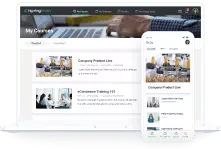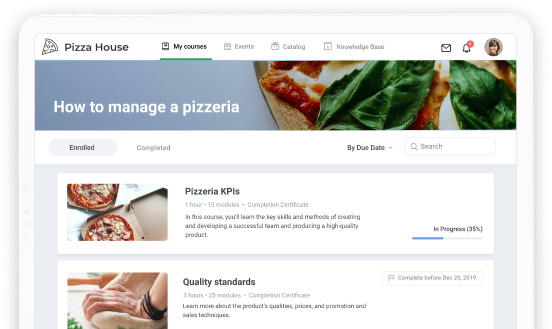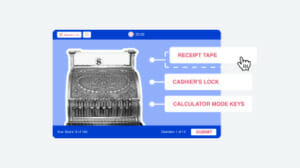3 Ways to Track Employee Training

Probably everyone in L&D loves to teach. Chunking complex subjects into small steps, turning tricky into easy, using those cool charts… Who really looks forward to monitoring all that? Okay, some of us like tracking training for employees, but most people would rather have this chore done for them. There is a solution that can do this, and even more, for you.
In this article, you’ll learn how to track employee training progress, why you should, and which training metrics to keep an eye on.
Why Track Employee Training
Tracking employee training progress provides you with objective data on training effectiveness. Without this, you can only guess what’s going on with your training programs and whether employees are taking them at all. That’s why many L&D professionals decide to track training at their company.
Here are some of the things training reports empower you to do:
Identify skill and knowledge gaps
You know for sure how many people were trained, what the average score is, who took a certain course, how well they passed a test, which parts should be optimized, etc. By analyzing this data, you can identify the precise knowledge gaps of your learners.
For example, let’s say your company rolled out an important product update, and you assigned the sales team a course that introduces them to the details of this update. By tracking their progress, you’ll be able to determine exactly which salespeople know about the update and who don’t.
Calculate ROI
You can decide whether your corporate training program is a good investment by calculating ROI and getting some hard numbers. Without training metrics, you have only half the puzzle — how much money you spent on training. Knowing how the training affected employees and business results requires detailed reports.
Improve training quality
Instead of guessing what works and what doesn’t, you can see the strengths and weaknesses of your training courses with precision and improve them accordingly.
For example, if you see that most learners fail the final test, there are probably some issues with your training program. It might lack enough information, there might be some tech issues, or anything else. But without training statistics, you would likely find it much later, if ever.
Prove training effectiveness
Training initiatives need investment, and to get investment, you need to show top management that it’s worthwhile. The only argument they’ll take is figures. Employee development tracking will provide you with plenty of data that will help you make the case for your future training initiatives.
3 Ways to Track Employee Training
You can monitor training progress either manually (by yourself) or automatically (using specialized software, like an LMS or a TMS). Let’s take a closer look at each of them.
Anyway, here is our shortlist of the ways to track employee training.
1. Learning Management System (LMS) – the Best Way to Track Employee Training
An LMS is a digital learning hub. It is a place where you can upload all the training materials, manage content, and assign it to learners. It also collects various statistics on the training process and can automatically create the necessary reports for you. In short,
using an LMS is the easiest and most adequate solution for monitoring training.
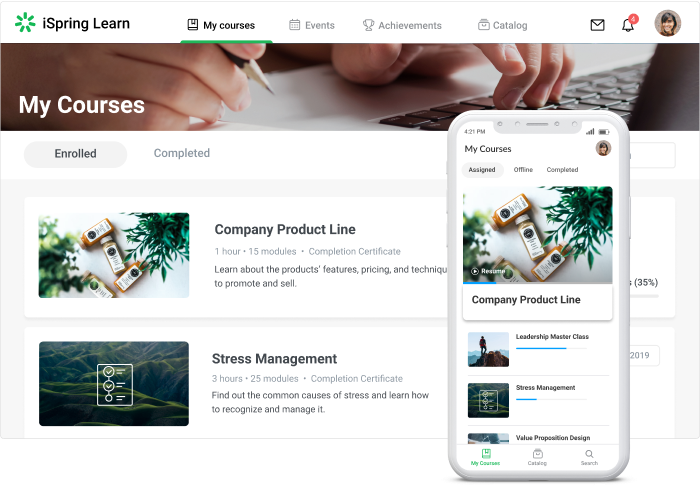
Learner portal in iSpring Learn LMS
How does it help to track training?
1) Automatization of repetitive tasks. An LMS automates daunting routine tasks such as gathering and processing statistics or grading.
Even if your team is small, say, you only have 30 learners, you still have to spend time finding out who needs training or who failed a test, fill in the current data, and regularly check their compliance statuses. You’ll also have to stay focused while doing this manual work to avoid blunders.
For an LMS, those are a matter of seconds. This means you don’t have to spend hours on creating reports manually in spreadsheets with hundreds of columns, as well as not having to deal with paper trails.
2) Extensive data analysis. Also, an LMS allows you to analyze in detail how learners interact with the content, how they’re progressing, and how each content item uploaded to the system performs. For instance, with the iSpring Learn LMS, you can:
- Go from overall progress to detailed statistics on a particular course or learner (or even how many seconds someone spent watching a certain slide, should you want to).
- Find out how users did on their assignments.
- Track attendance of events.
- Apply filters and customize report columns to distill the information that is important to you, and more.
3) Keeping training records. It doesn’t matter how many learners you have — 5 or 5,000 — with an LMS, you can monitor their progress in real-time. The LMS also documents every past training you held, which is especially important in terms of compliance issues.
2. Training Management System (TMS) – Advanced Administrative Functionality
A TMS is a specialized type of software for managing training processes for instructor-led training, which is mostly used by enterprises. Unlike LMSs that are learner-centric, TMSs target administrators and organizational activities that happen before any class takes place. In general, it can be compared with a CRM system.
The basic features of a TMS may include:
- Managing session plans
- Budgeting
- Logistics and resource management
- Booking management
- Creating reports for business intelligence
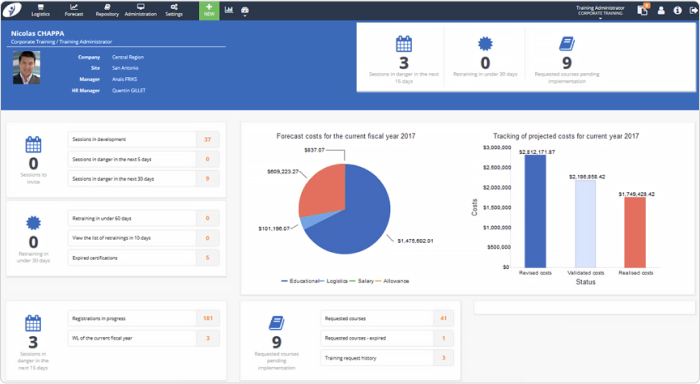
Training Orchestra, a training resource management system.
Image credit: David Patterson, Learning Light
3. Excel and Google Spreadsheets – Low-Cost Workarounds
Deploying a full-fledged learning portal can cost a pretty penny, so not every company can afford it right away. Some have to wait for the next financial year to try to get the budget; others just would like to start small to better see their requirements for an employee training tracking system. But everyone has something in common — the need to start doing it right now. What can you do then?
Well, don’t panic. Good old spreadsheets are a surefire way to get plenty of things done. You can choose either Microsoft Excel or Google Sheets, either of which you’re likely to already have. The functionality of the two programs is similar. While Excel is supposed to be more powerful, Google Spreadsheets provides collaboration capabilities. If you have more than one person who will record training logs for employees, we’d advise choosing the second option.
We’ve also created a training tracker spreadsheets template for you to use as a starting point. This template consists of three tabs:
- Training log (serves as a makeshift dashboard).
- Courses (a list of the training activities or training courses).
- Learners (well, a list of learners).
Every time you have a training session, you’ll need to manually enter data into the table. Plus, there are some sorting filters, so you can at least quickly see who has already taken a certain course and who hasn’t. Feel free to save it to your disk and customize as much as you wish.
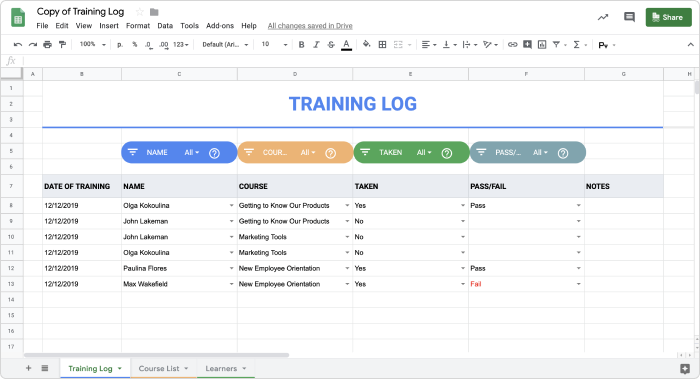
Just be careful not to forget to fill out the details after each training
What Training Metrics Should You Track?
Now that we’ve discussed how to track training progress, it’s time to look at what to track. Even more than it was with the tools for tracking employee training, there’s no one-size-fits-all set for training KPIs. Here are four key metrics you can start from, though, even if you don’t have any employee training software yet.
1. Training completion rate
This metric shows how many learners have taken a course or studied your training content. There are two reasons to track it:
- Compliance. For mandatory compliance training, you’ll need a 100% course completion rate by a certain deadline. It’s very important to get your employees trained and make sure that everyone is marked as compliant to provide a better work environment and minimize risks for the company.
- Engagement. High course completion rates for non-mandatory training demonstrate that the content is relevant for learners. If engagement is low, then you’ll need to find out why the course was abandoned. Maybe learners’ motivation for training is low, the content is not qualitative enough, or, perhaps, learners simply don’t know there’s training.
If necessary, you can also break an overall course completion rate down into segments, such as training completion rate per department or job. This will help to quickly identify which group is lagging behind and prevent potential problems with non-compliance.
2. Pass/fail rate
This metric mostly refers to tests and quizzes and indicates whether your learners managed to successfully finish their training or not.
This one can be tricky. It seems like a good sign when all the learners pass the test at the first attempt, meaning they were well-prepared. On the other hand, it can also indicate that the test was just too easy, which makes it useless. On the contrary, a sudden rash of ‘fails’ may signal that something’s wrong and requires your attention. In any case, we’d advise viewing this metric regularly.
3. Soft skills change
Soft skills are extremely important nowadays, yet they’re some of the most difficult to monitor. With hard skills, tracking is quite easy: an employee either knows how to do something or they don’t. Quizzes and tests will show this right away. With soft skills, however, you will need a 360-degree feedback assessment.
In short, to conduct this type of assessment, you need to collect feedback on an employee’s performance from everyone who works with them regularly. Then, you need to analyze their responses and evaluate the person’s soft skills based on those.
Traditional 360-degree assessment usually takes quite a long time — up to a month. However, you can conduct it in a single day with iSpring Learn. Our LMS surveys an employee’s colleagues, collects their responses, and generates illustrative reports.
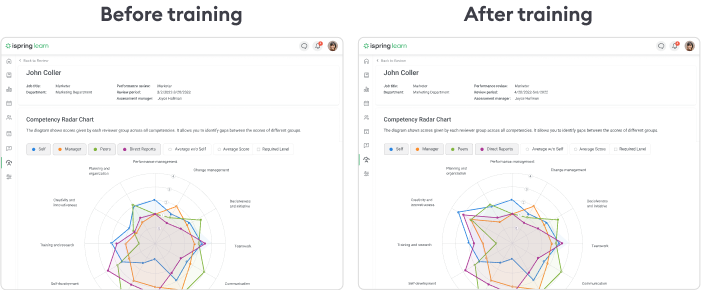
Since it’s so fast and easy, you can conduct such assessments regularly and compare results to measure the effectiveness of training over time.
4. Post-event survey results
This metric is for instructional designers, trainers, and facilitators. It allows you to get feedback from users about the training they’ve taken, and thus you’ll be able to improve it.
For the basic surveys, you can use Google Forms, a free service for building polls.
A more advanced yet easy-to-use solution is iSpring QuizMaker. This helps you create interactive tests, quizzes, and surveys with custom scoring and branching in no time. Also, tests created with iSpring QuizMaker can be published in eLearning formats, such as SCORM, AICC, cmi5, and xAPI, so you can upload them to your LMS (should you use it) and easily gather all the assessment statistics.
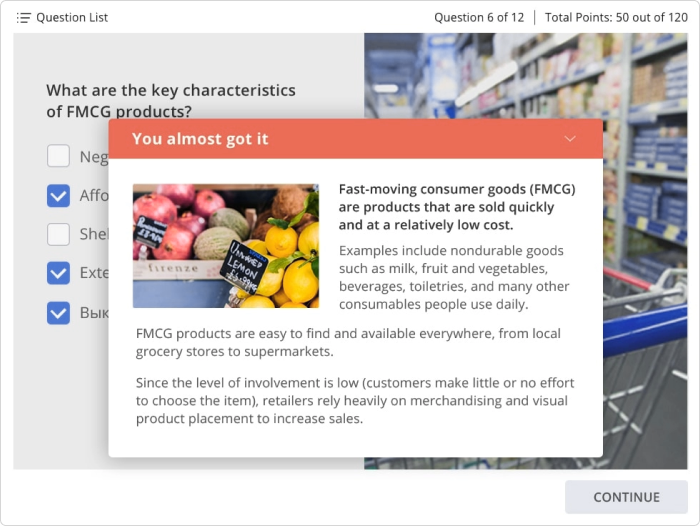
iSpring QuizMaker
These were the key metrics that can be measured even if you only use spreadsheets. Of course, having an LMS makes the process much easier and provides access to advanced data and reports.
Here in the iSpring blog, we have a couple of more detailed blog posts on measuring training effectiveness:
- Understanding LMS Reports: 12 Things to Look at in Your eLearning Statistics
- Training Metrics: How to Measure eLearning Effectiveness
- How to Measure eLearning ROI: From Smile Sheets to Hard Numbers
- A Supervisor Dashboard: Track Learner Progress with iSpring Learn
- Remote Employee Onboarding: How to Do It Right
Now, it’s your turn
Tracking your employee training is necessary to make sure that the staff is up to date. It can save you a headache in any compliance-related issues. It can teach you to make better learning after all.
Why not start right now?
Start by creating your first learning portal with iSpring Learn to see how an LMS works. It’s free to try and doesn’t require your credit card number or anything. But if you want to, you could also leave your contact details, so someone from the iSpring team can reach you to learn more about your business, goals, and help you get to know the platform.
If you aren’t ready to do this yet, that’s absolutely fine. Just let us know if the article was useful or if you have any questions in the comments below.
FAQ
How do you track employee training attendance?
If you have an LMS, like iSpring Learn, it will track your employees’ online training activity automatically. If you also conduct in-person sessions, you’ll need to keep track of employees’ attendance at offline events and then add that data to the LMS.
How do you maintain training records in the workplace?
The best way to maintain training records is to use a learning management system. It will guarantee that you won’t lose or damage them and that they’ll remain secure and always be at hand.
How do you audit staff training?
Create a list of your current training programs. Analyze training metrics and learners’ feedback. Examine employees’ performance. Evaluate your current training based on the results of your analysis and how they align with your training goals.
